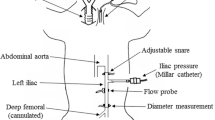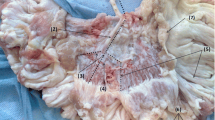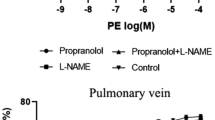Abstract
Effects of inhibition of calcium-dependent potassium channels (K +Ca channels) on the regulation of arterial and venous tone by nitric oxide (NO) were studied in anaesthetized pigs following vagotomy and blockade of autonomic ganglia. Selective inhibition of K +Ca channels by charybdotoxin (CTX, 2 gmg/kg iv) or iberiotoxin (IbTX, 1 μg/kg) significantly augmented mean total peripheral resistance (TPR) to levels 30–60% above control. Venous and pulmonary vascular tone were assessed by changes in effective compliances of the venous (EVC) and pulmonary (EPC) vascular beds as calculated from changes in central venous and diastolic pulmonary arterial blood pressure during haemorrhagia (− 5 ml/kg) and hypervolaemia (+5 ml/kg). Blockade of K +Ca channels significantly decreased both EVC (−20 to −30%) and EPC (−30 to −50%). Both CTX and IbTX significantly diminished the vasodilation caused by the NOdonor S-nitroso-N-acetylpenicillamine (SNAP) both during control conditions and following experimental vasoconstriction induced by systemic inhibition of NO-synthesis by NG-nitro-L-arginine methyl ester (L-NAME) or infusion of vasoconstrictor agonists. Dilator effects of the adenosine 3′,5′-cyclic monophosphate (cAMP)-dependent agonist adenosine were only slightly reduced. However, blockade of K +Ca channels did not increase vasoconstriction induced by L-NAME significantly. These results suggest that activation of vascular K +Ca channels is an important mechanism by which NO attenuates the constrictor tone of resistance and capacitance vessels in vivo.
Similar content being viewed by others
References
Archer SL, Huang JMC, Hampl V, Nelson DP, Shultz PJ, Weir EK (1994) Nitric oxide and cGMP cause vasorelaxation by activation of a charybdotoxin-sensitive K channel by cGMP- dependent protein kinase. Proc Natl Acad Sci USA 91:7583–7587
Bialecki RA, Stinson-Fisher C (1995) KCa channel antagonists reduce NO donor-mediated relaxation of vascular and tracheal smooth muscle. Am J Physiol 268:L152-L159
Bolotina VM, Najibi S, Palacino JJ, Pagano PJ, Cohen RA (1994) Nitric oxide directly activates calcium-dependent potassium channels in vascular smooth muscle. Nature 368:850–853
Brayden JE, Nelson MT (1992) Regulation of arterial tone by activation of calcium-dependent potassium channels. Science 256:532–535
Busse R. Mülsch A, Fleming I, Hecker M (1993) Mechanisms of nitric oxide release from the vascular endothelium. Circulation 87 (Suppl. 5):V18-V25
Caldini P, Permutt S, Waddell JA, Riley RL (1974) Effect of epinephrine on pressure, flow, and volume relationships in the systemic circulation of dogs. Circ Res 34:606–623
Deschamps A, Magder S (1994) Effects of heat stress on vascular capacitance. Am J Physiol 266:H2122-H2129
Echt M, Düweling J, Gauer OH, Lange L (1974) Effective compliance of the total vascular bed and the intrathoracic compartment derived from change in central venous pressure induced by volume changes in man. Circ Res 34:61–68
Ellis JL, Conanan ND (1994) Effect of potassium channel blockers on relaxations to a nitric oxide donor and to nonadrenergic nerve stimulation in guinea pig trachea. J Pharmacol Exp Ther 271:782–786
Eisner D. Stewart DJ. Sommer O, Holtz J, Bassenge E (1986) Postsynaptic alpha 1 — and alpha2-adrenergic receptors in adrenergic control of capacitance vessel tone in vivo. Hypertension 8:1003–1014
Feelisch M, Te Poel M, Zamora R, Deussen A, Moncada S (1994) Understanding the controversy over the identity of EDRF. Nature 368:62–65
Furchgott RF, Vanhoutte PM (1989) Endothelium-derived relaxing and contracting factors. FASEB J 3:2007–2018
Gardiner SM, Compton AM, Kemp PA, Bennett T (1990) Regional and cardiac haemodynamic effects of NG-nitro-L-argi- nine methyl ester in conscious, Long-Evans rats. Br J Pharmacol 101:625–631
Garland CJ, Plane F, Kemp BK, Cocks TM (1995) Endothelium-dependent hyperpolarization: a role in the control of vascular tone. Trends Pharmacol Sci 16:23–30
Hannon JP, Bossone CA, Wade CE (1990) Normal physiological values for conscious pigs used in biomedical research. Lab Anim Sci 40:293–298
Herd JA (1991) Cardiovascular response to stress. Physiol Rev 71:305–330
Holtz J, Bassenge E, Kinadeter H, Kolin A (1981) Increased effective vascular compliance and venous pooling of intravascular volume during sustained venodilation in conscious dogs. Basic Res Cardiol 76:657–669
Khan SA, Mathews WR, Meisheri KD (1993) Role of calciumactivated K+ channels in vasodilation induced by nitroglycerine, acetylcholine and nitric oxide. J Pharmacol Exp Ther 267:1327–1335
Lundvall J, Edfeldt H (1994) Very large range of baroreflex sympathetic control of vascular resistance in human skeletal muscle and skin. J Appl Physiol 76:204–211
Meininger GA, Davis MJ (1992) Cellular mechanisms involved in the vascular myogenic response. Am J Physiol 263: H647-H659
Moncada S, Palmer RMJ, Higgs EA (1991) Nitric oxide: physiology, pathophysiology, and pharmacology. Pharmacol Rev 43:109–142
Monos E, Bérczi V, Nádasy G (1995) Local control of veins: biomechanical, metabolic, and humoral aspects. Physiol Rev 75:611–666
Nelson MT (1993) Ca2+-activated potassium channels and ATP-sensitive potassium channels as modulators of vascular tone. Trends Cardiovasc Med 3:54–60
Nelson MT, Quayle JM (1995) Physiological roles and properties of potassium channels in arterial smooth muscle. Am J Physiol 268:C799-C822
Nelson MT, Cheng H, Rubart M, Santana LF, Bonev AD, Knot HJ (1995) Relaxation of arterial smooth muscle by calcium sparks. Science 270:633–637
Neylon CB, Avdonin PV, Dilley RJ, Larsen MA, Tkachuk VA, Bobik A (1994) Different electrical responses to vasoactive agonists in morphologically distinct smooth muscle cell types. Circ Res 75:733–741
Palmer RMJ, Ferrige AG, Moncada S (1987) Nitric oxide release accounts for the biological activity of endotheliumderived relaxing factor. Nature 327:524–526
Pegoraro AA, Carretero OA, Sigmon DH, Beierwaltes WH (1992) Sympathetic modulation of endothelium-derived relaxing factor. Hypertension 19:643–647
Robertson BE, Schubert R, Hescheler J, Nelson MT (1993) cGMP-dependent protein kinase activates Ca-activated Kchannels in cerebral artery smooth muscle cells. Am J Physiol 265:C299-C303
Stewart DJ, Eisner D, Sommer O, Holtz J, Bassenge E (1986) Altered spectrum of nitroglycerin action in longterm treatment: nitroglycerin-specific venous tolerance with maintenance of arterial vasodepressor potency. Circulation 74:573–582
Taniguchi J, Furukawa KI, Shigekawa M (1993) Maxi K+ channels are stimulated by cyclic guanosine monophosphate-dependent protein kinase in canine coronary artery smooth muscle cells. Pflügers Arch 463:167–172
Vanheel B, Voorde J van de, Leusen I (1994) Contribution of nitric oxide to the endothelium-dependent hyperpolarization in rat aorta. J Physiol (Lond) 475:277–284
Zanzinger J, Bassenge E (1994) Low dose calcium-antagonism compensates for impaired myocardial blood supply resulting from deficient nitric oxide synthesis. Naunyn Schmiedeberg’s Arch Pharmacol 350:185–188
Zanzinger J, Czachurski J, Seller H (1994) Inhibition of sympathetic vasoconstriction is a major principle of vasodilation by nitric oxide in vivo. Circ Res 75:1073–1077
Author information
Authors and Affiliations
Rights and permissions
About this article
Cite this article
Zanzinger, J., Czachurski, J. & Seller, H. Role of calcium-dependent K+ channels in the regulation of arterial and venous tone by nitric oxide in pigs. Pflügers Arch. 432, 671–677 (1996). https://doi.org/10.1007/s004240050184
Received:
Accepted:
Published:
Issue Date:
DOI: https://doi.org/10.1007/s004240050184




